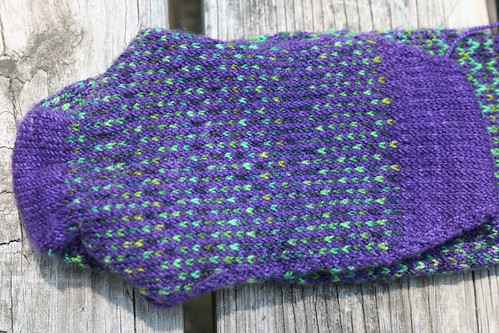Sensational Socks!

Pattern: Based on the "Pine and Neon" Four-Stitch Reticulated Patterns socks from Sensational Knitted Socks by Charlene Schurch.
Yarn: 3 skeins Koigu KPPPM/KPM (100% wool). 2 skeins KPM 7160 (Purple), 1 skein KPPPM 841 (Greens and Black)
Needles: 2.5mm (US 1)
Gauge: 19 sts x 21 rows = 2 inches over stranded stockinette
Knitting Time and Date Completed: 4 weeks, completed 08/27/07
Notes: There were two things that I'd wanted to do for a long time: Try Koigu, and knit some patterned socks. This project from Sensational Knitted Socks was just the thing to satisfy both desires. I love purple and green, and the moment I spotted these two colors I knew what I wanted to do with them. This was my first experience with Koigu, and I understand now why people rave about it. It's lovely to knit with, soft and springy, and even the solids in plain stockinette create all manner of interesting textures. It was a joy to work with, and I was sorry to reach the end of the project.

As always with any technique I've not tried before, these were a learning experience. I'd done stranded work, so the knitting part wasn't difficult. But I'd never done colorwork with a variegated yarn before and I made a basic mistake when I picked my colors, namely that the variegated yarn contained some colors that were as dark as the main solid. This meant that part of the pattern would be lost when the contrast yarn matched the solid yarn. I considered choosing another color, but I really liked the way the green and purple looked together and decided that I could live with some pattern blurring. It turned out to a be a good decision. Yes, some of the pattern fades into the background, and it's not an effect that everyone would find pleasing, but I love the two yarns together so much that I find that I don't really care.

The second learning experience involved the heel turning. Because of the colorwork, the entire sock is knitted with two strands of yarn, with the exception of the heel turning and the toe. I didn't really think about it while I was turning the heel, but once I started on the foot I realized that the bottom of the heel, knitted with only one color and one strand, was a very different thickness and texture than the rest of the sock. Since this isn't an area that typically wears out on my socks, I decided I wouldn't worry about it, but when I got to the toe I simply dropped the contrast yarn and picked up a second strand of the solid, working the toe by alternating the two yarns as in two-end/tvaandstickning. I was very pleased with the result. Although it's still a solid color, the toes match the rest of the sock in texture and thickness.

Speaking of toes, I also ran into a bit of a toe problem with the first sock. In the pictures, you can see the first sock as I originally finished it, worked with decreases every other round. For every other sock I've ever made, decreasing every other round has made a perfect toe. For some reason, though, my row gauge was considerably larger than I'm used to, and by the time the toe was more than long enough, I still had about twice as many stitches as I wanted. I went ahead and finished it, figuring I could knit the second sock while I was considering whether or not to alter the toe. I decided rather quickly that I didn't like the wide toe, so for the second sock I decreased every round. It came out perfect, so I cut the tip off the first toe, ripped it back, and re-knitted it the same way as the second.



3 Comments:
I think row gauge in colorwork is very different...don't quote me, but I think the stitches are a bit more square or elongated or something. :)
Yeah, that's what I'm thinking. It tends to be tighter side to side than if it's not stranded, I think. I just started a colorwork pattern where the given stitch and row gauge are the same, in fact.
Those turned out really well! I actually like the pattern fading a bit when the colors are closer together, it adds something to the socks.
Post a Comment
<< Home